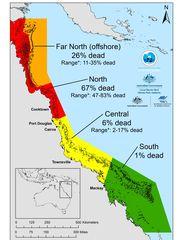The increase of the pacific ocean surface temperature is less than 1°C Coral reefs live close to the surface and therefore some effect may be due to increased surface temp due to global warming. If this small change is the sole reason for the die off of coral then it will be completely dead by the time the ocean temp changes by another 1°C, which seems to be around the minimum predicted increase.
It is quite possible that much of the die off besides that amount caused by the plague of the crown-of-thorns starfish is due to chemical fertiliser run off from north qld farms. Increased levels of phosphorous from fertiliser run off detected in coral is known to weaken and sometimes kill coral. There needs to be much more regulation on fertilisers especially on cane farms. Cane farms have been an environmental disaster for Australia.
Results 1 to 16 of 16
Hybrid View
-
30-11-2016, 08:19 AM #1last farang standing
































- Join Date
- May 2015
- Last Online
- Yesterday @ 10:49 PM
- Location
- Qld/Bangkok
- Posts
- 4,199
-
30-11-2016, 08:38 PM #2Member



















- Join Date
- May 2016
- Last Online
- 09-04-2017 @ 02:40 AM
- Posts
- 288
There have been at least 4 die offs in the last 30 years and guess what? Yesss they recovered fast every time! A miracle! What isn't a miracle is how the greens took this normal state of affairs and created a crisis event of world magnitude out of it over and over. What is becoming apparent to people tho is that its a normal pattern of events. And another normal pattern of events is green climate hysteria.
-
30-11-2016, 09:35 PM #3
And the fucking muppet is along with his bizarre theories, none of which pay ANY attention to the scientific evidence offered.

Scientists have confirmed the largest die-off of corals ever recorded on Australia’s Great Barrier Reef.
https://teakdoor.com/world-news/17110...coral-die.html (Scientists Record Biggest Ever Coral Die-off on Australia's Great Barrier Reef)The worst affected area, a 700 km swath of reefs in the northern region of the Great Barrier Reef has lost an average of 67% of its shallow-water corals in the past 8-9 months. Further south, over the vast central and southern regions of the Great Barrier Reef, the scientists were relieved to find a much lower death toll.
“Most of the losses in 2016 have occurred in the northern, most-pristine part of the Great Barrier Reef. This region escaped with minor damage in two earlier bleaching events in 1998 and 2002, but this time around it has been badly affected,” says Professor Terry Hughes, Director of the Australian Research Council (ARC) Centre of Excellence for Coral Reef Studies based at James Cook University, who undertook extensive aerial surveys at the height of the bleaching.
Thread Information
Users Browsing this Thread
There are currently 1 users browsing this thread. (0 members and 1 guests)






 Reply With Quote
Reply With Quote

